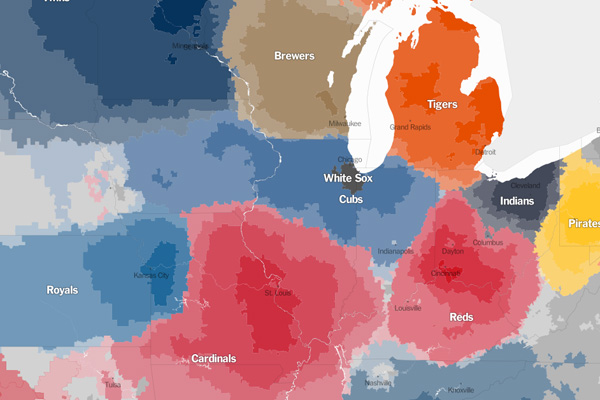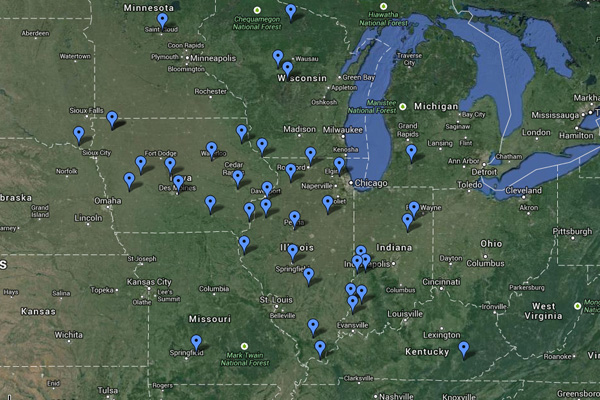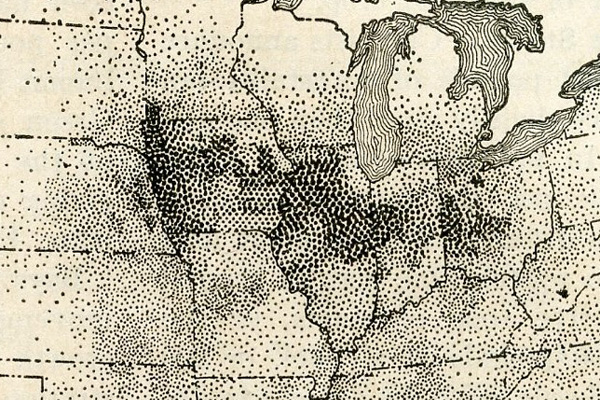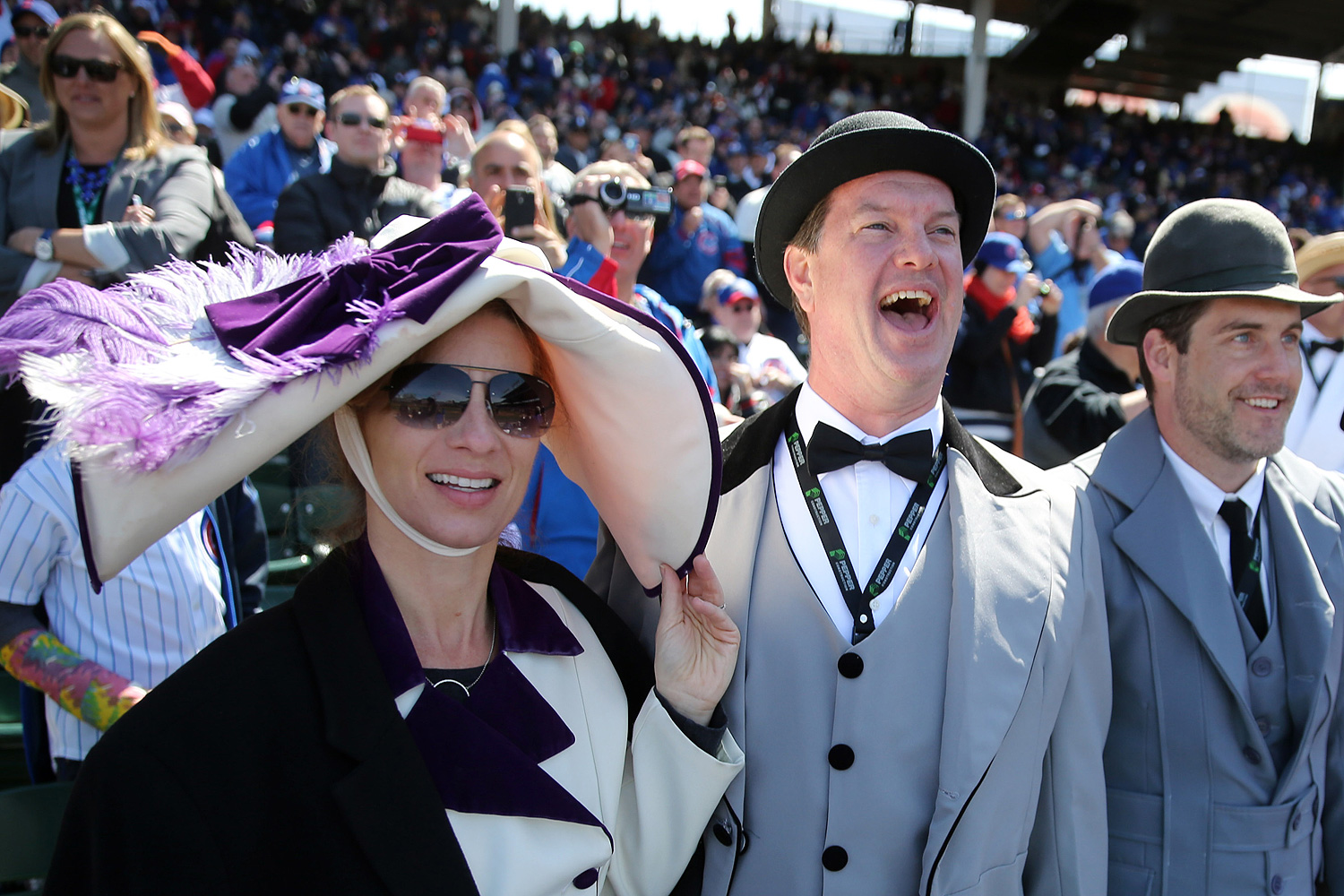It was one day as I listened to baseball that it occurred to me how the moon actually moves, in a spiral, because while it orbits the earth it also follows the orbit of the earth around the sun. This is obvious, but the realization pleased me. There was a full moon outside my window, icy white in a blue sky, and the Cubs were playing Cincinnati.
—Marilynne Robinson, Gilead
The New York Times has a wonderful map, drawn from Facebook data, that depicts the extent of baseball teams' fanbases. Being Facebook data, it's worth taking with a grain of salt, but it does seem to reflect reality in my anecdotal experience. For instance, Cubs Nation versus White Sox Breakaway Republic:

I wrote a bit about this on Wednesday: the Wrigley family's embrace of radio and television to build the Cubs' brand in the greater Midwest, versus the White Sox's fear that those media would reduce ticket sales, allowed the former to become a massive regional team, and to a certain extent a national one (after the Yankees and Red Sox, of course).
Seeing the NYT map made me a bit more curious about this. The Cardinals also have extraordinary scope, particularly within the disputed downstate territory of Illinois, but also ranging into the southern Great Plains and the Delta. Two old, beloved National League teams, competing against each other: what would cause these patterns?
The NYT authors cleverly hint that Illinois voting patterns in the presidential election of 1860 mirror the Cubs-Cardinals line in the state. And it's eerily similar, suggesting a North-South sociopolitical divide.
But the Cubs still have that massive sweep from far western Ohio into eastern Nebraska, where a couple counties have a bare plurality of Cubs fans, despite being closer to both St. Louis and Kansas City.
And Cubs Nation does follow the extent of its radio network; here's a map of stations from 2008 that pretty well reflects the current state of the Cubs radio network. (The White Sox's network is half as large, and entirely within Illinois and Indiana, save for one station just over the river in Burlington, Iowa.)

But which came first, the market or the stations?
Wrigley's idea was that if you offer up Cubs games on the radio to places far outside of Chicago, you'll build an extensive fan base that will go to the games when they're in the city.
So I thought a bit about what would bring people to Chicago in the 1920s, when the team started building its radio network. (Ronald Reagan was a Cubs announcer in Iowa in the 1930s, doing play-by-play from a telegraph.) And both the Cubs Nation map and the radio-network map look an awful lot like the hinterlands that William Cronon describes in Nature's Metropolis, his canonical book about Chicago's early economic history. Grain from Iowa and timber from Wisconsin, going by rail and water to Chicago to be valued and sold.
Cronon's book covers an earlier period of history, but the parallels between Chicago and St. Louis competing to be the Midwest's economic center, and the Cubs and Cardinals competing for fans at the edge of the baseball world—the Cardinals immediately copied the Cubs' radio strategy—were compelling. Chicago was, economically, oriented east and west, connecting the northern Midwest to the Eastern economic powers; St. Louis's big trading partner was New Orleans.
And if you're looking for a broad swath of people who will have reason to be in your city periodically, people who have business in the city are an obvious audience.
Now take a look at corn production in the Midwest circa 1920, via Eric Fischer:

Again, it looks a lot like Cubs Nation—western Ohio, central Indiana and Illinois, throughout Iowa west to the Nebraska border.
Meanwhile, here's a map of the Cardinals' radio network.

It looks like the St. Louis economic hinterlands that Cronon describes in Nature's Metropolis:
The regional credit hinterland in which St. Louis's bankrupts did most of their business consisted principally of southern Illinois and centural Missouri. [I.e. borrowers in those places borrowed from firms in St. Louis. N.b., here Cronon is adopting the work of the University of Chicago's Michael Conzen, whom I took a class from and who introduced me to this way of thinking about economics and history.] Chicago's trade region, on the other hand, included these two areas in addition to the rest of Illinois, Wisconsin, Minnesota, Iowa, and communities still farther west.
[snip]
By looking at medium-sized cities that used Chicago's banks for their principal correspondent relations, one discovers that Chicago's financial hinterland in 1881 extended from Cleveland in the east to Denver in the west…. In contrast, St. Louis had a much humbler banking hinterland by the 1880s. The most important medium-sized city that depended on correspondent banks in St. Louis was St. Joseph, within the boundaries of the same state, and the rest of St. Louis's regional banking was with cities in Arkansas and Texas…. In banking terms, all that remained of its once-proud empire was the narrow band of three states running southwest towards the Rio Grande.
It's correlation, not causation, obviously; it doesn't take into account how the Cubs' radio network spread over nearly a century. But the Cubs have been in Iowa for a long, long time, as echoed by Marilynne Robinson in her depiction of rural Iowa in the early 20th century.
Perhaps William Wrigley, a sophisticated marketer, realized how Chicago drew people into its orbit, and from where they came in the 1920s, as described by Cronon: "often, as was the case of St. Louis and then Chicago, the gateway city's hinterland was often extremely elongated, stretching hundreds and even thousands of miles to the west but a much shorter distance to the east." Perhaps it evolved more organically than that. Either way it worked, as evidenced by my favorite little detail of the map.

That little foothold of Cubdom is Hyde Park—which, as a former resident, I can confirm leans to the North Siders despite being much more convenient to the (typically more affordable) Cell. And it's the one tiny piece of Sox country that's mostly transplants, a migratory population constantly renewed by the University of Chicago's hinterlands: America, and the overlapping hinterland of the World's Greatest Network.
Update: Here's a neat map of MLB territories by proximity—in other words, if everyone in America rooted for the team closest to them, what their reach would look like. The extent of Cubs fandom looks more impressive still by this measure, as only the Mets appear to have a smaller natural geographic fanbase.




